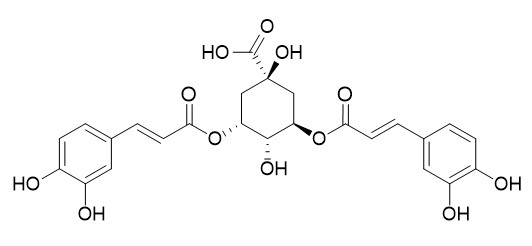3,5-Dicaffeoyl-epi-quinic acid
3,5-Dicaffeoyl-epi-quinic acid shows anti-inflammatory activity, it may improve mast cell-mediated inflammatory diseases.
Inquire / Order:
manager@chemfaces.com
Technical Inquiries:
service@chemfaces.com
Tel:
+86-27-84237783
Fax:
+86-27-84254680
Address:
1 Building, No. 83, CheCheng Rd., Wuhan Economic and Technological Development Zone, Wuhan, Hubei 430056, PRC
Providing storage is as stated on the product vial and the vial is kept tightly sealed, the product can be stored for up to
24 months(2-8C).
Wherever possible, you should prepare and use solutions on the same day. However, if you need to make up stock solutions in advance, we recommend that you store the solution as aliquots in tightly sealed vials at -20C. Generally, these will be useable for up to two weeks. Before use, and prior to opening the vial we recommend that you allow your product to equilibrate to room temperature for at least 1 hour.
Need more advice on solubility, usage and handling? Please email to: service@chemfaces.com
The packaging of the product may have turned upside down during transportation, resulting in the natural compounds adhering to the neck or cap of the vial. take the vial out of its packaging and gently shake to let the compounds fall to the bottom of the vial. for liquid products, centrifuge at 200-500 RPM to gather the liquid at the bottom of the vial. try to avoid loss or contamination during handling.
Chem Biodivers.2023, 20(10):e202300741.
J Asian Nat Prod Res.2019, 5:1-17
Biomol Ther (Seoul).2024, 32(5):546-555.
Arch Pharm Res.2015, 38(6):1080-9
Pharmaceutics.2023, 15(9):2355.
Molecular & Cellular Toxicology 2024, 00444-8.
J Mass Spectrom.2022, 57(2):e4810.
Int J Mol Sci.2022, 23(13):7115.
Journal of Research in Pharmacy.2022, 26(6):p1752-1757.
Chemistry of Vegetable Raw Materials2019, 3:119-127
Related and Featured Products
Immunopharmacol Immunotoxicol. 2018 Feb;40(1):52-58.
Anti-inflammatory effects of Artemisia scoparia and its active constituent, 3,5-dicaffeoyl-epi-quinic acid against activated mast cells.[Pubmed:
29172841 ]
Artemisia scoparia Waldst. et Kit. (AS) has been used to treat inflammation, urticaria and hepatitis. However, the scientific studies of AS and its active compound for inflammatory reactions in activated human mast cell line, HMC-1 cells have not yet been elucidated.
METHODS AND RESULTS:
Here, we isolated 3,5-Dicaffeoyl-epi-quinic acid (DEQA) from AS butanol fraction. The anti-inflammatory effect of AS and its new active compound, DEQA was examined in HMC-1 cells by studying the following markers: phorbol 12-myristate 13-acetate and calcium ionophore A23187 (PMACI)-induced thymic stromal lymphopoietin (TSLP), tumor necrosis factor (TNF)-α, interleukin (IL)-1β and IL-6 secretion and mRNA expression by ELISA and RT-PCR, respectively. Furthermore, mechanism related to anti-inflammatory was examined by Western blotting. We reported that AS and its new active compound, DEQA significantly reduced TSLP, TNF-α, IL-1β and IL-6 production levels through the reduction of caspase-1 activity. The mRNA expression of these inflammatory cytokine was also reduced via blocking nuclear factor-κB nuclear translocation by AS and DEQA. In addition, AS significantly reduced phosphorylated-c-Jun N-terminal kinase level and DEQA significantly reduced both phosphorylated-c-Jun N-terminal kinase and -p38 mitogen-activated protein kinase levels.
CONCLUSIONS:
Therefore, these results indicated that AS and its active compound, DEQA may improve mast cell-mediated inflammatory diseases.
Clin Exp Dermatol. 2018 May 8.
Therapeutic effects of Artemisia scoparia Waldst. et Kitaib in a murine model of atopic dermatitis.[Pubmed:
29740850 ]
Artemisia scoparia Waldst. et Kitaib (AS) (Oriental wormwood, known as Bissuk in Korea) is a plant used in cosmetic and pharmaceutical treatments. However, the effect of AS on atopic dermatitis (AD) has not been described. To examine the inhibitory effect of AS on AD using a murine model.
METHODS AND RESULTS:
We applied either AS, the butanol-extracted fraction of AS (Bu-OH) or 3,5-Dicaffeoyl-epi-quinic acid (DEQA, a major component of Bu-OH) topically for 3 weeks to 2,4-dinitrofluorobenzene (DNFB)-induced skin lesions in BALB/c mice. AS, Bu-OH and DEQA suppressed the clinical symptoms of DNFB-induced skin lesions and he associated scratching behaviour. Numbers of inflammatory cells infiltrating skin lesions were significantly reduced by AS or Bu-OH application but not by DEQA. In addition, AS significantly suppressed serum levels of histamine and IgE, while Bu-OH significantly suppressed serum levels of histamine, IgE, thymic stromal lymphopoietin (TSLP), interleukin (IL)-4 and IL-6, and DEQA significantly suppressed serum levels of histamine, IgE, TSLP and IL-4 in DNFB-induced AD mice. In skin lesions, AS and Bu-OH significantly reduced inflammatory cytokines, whereas DEQA did not. AS, Bu-OH and DEQA all significantly suppressed caspase-1 activities.
CONCLUSIONS:
These results demonstrate the anti-AD effects of AS, Bu-OH and DEQA, and suggest that all three have therapeutic potential.



